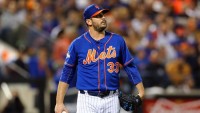Matt Harvey

No matter how you slice or dice it, the Mets have gone from an under .500 team to taking over New York in one year. How did they do it?
For starters, the Mets went to the World Series. They went on a magical run and came up just short. Additionally, they have assembled a roster that is more than capable of returning to the World Series this year, but also in years to come. Just as important as all of this, the Mets have a team that is good to the fans. Even after a loss in the World Series, they came out to share the moment with the fans. The fans love this team, and the feelings seem mutual.
One major reason why the fans love the team is the larger than life personalities on the team.
Matt Harvey travels across the talk show circuit like he’s got a movie about to be released even though “The Dark Knight Rises” was released in 2012. No, it’s not a coincidence that the movie was released the year he was first called up to the majors.
After the World Series, Noah Syndergaard took his own victory tour going to each New York stadium letting them know he owned the city. He actively accepts and plays off the Thor superhero moniker bestowed upon him. He knows what everyone thinks about when they think if him, and then he goes about playing along on Twitter:
Spring Training packing checklist:
-glove✔️
-spikes✔️
-mjolnir?✔️
-lunch box ?— Noah Syndergaard (@Noahsyndergaard) February 4, 2016
RT @statcast Your eyes did not deceive you. @Mets starters just throw harder than the rest.https://t.co/tqILsn0vDg pic.twitter.com/cjnAm0Dl6e
— Noah Syndergaard (@Noahsyndergaard) February 4, 2016
By the way, before he came to the majors, he was thought of as the quiet one.
Overall though, no one moves the needle more than Yoenis Cespedes. He’s got swagger. Say what you will about him, but he is just cool. There are people and players that have that aura. Whatever you want to call it, Cespedes had it. Speaking of which, did you see that car?!?!?
This is Yoenis Cespedes's vehicle today. Unreal. pic.twitter.com/oUMz9HNEP5
— Robert Brender (@robertbrender) February 23, 2016
More shots of Cespedes's new three-wheel ride. Mets teammates even came out to see it. pic.twitter.com/29CkA5Srqf
— Andrew Beaton (@andrewlbeaton) February 23, 2016
Harvey has a Maserati, and people don’t even notice it. For what it’s worth, Harvey could’ve driven a Honda Civic today. No one noticed. Do you realize how big of a person or personality you need to be to make people not notice Matt Harvey?
That’s why the Mets own New York. They get it. They accept and return the fans’ love. They have a certain cool about them. They’re confident. They’re fun. They’re awesome on and off the field.
That’s why the Mets own New York.
(Photo from Mets Twitter account)
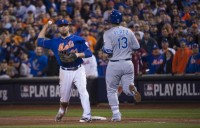
In 2014, the Royals were 90 feet away from scoring the tying run of the World Series. Even though most agreed Alex Gordon made the right decision stopping at third, his decision became a topic of discussion when Madison Bumgarner got Salvador Perez to foul out to end the World Series.
The game tying run was forever stranded at third.
Fast forward to the 2015 World Series.
With the exception of Game 2, the Mets had a late lead in each game. They got to that point despite the Mets starting pitching not having one truly great game. In fact, the Mets starting pitching had been somewhat disappointing. With that said, they pitched well enough to put the Mets in position to win four of the five games.
Then the pitching showed up in Game 5. Matt Harvey shut down the Royals much in the same way Bumgarner had shut down the Royals. Jacob deGrom and Noah Syndergaard were ready to go for Games 6 & 7. Before the ninth inning, the Royals had a dejected look in the dugout. Even if they were up 3-1 in the series, they were in real trouble. The Mets great starting pitching had awoken.
In the fateful ninth inning, Eric Hosmer was on third base. He was 90 feet away. Then this happened:
Hosmer had no business running there. None. He was the last out of the game. However, when 90 feet separated you from a World Series championship the previous year.
Yes, we heard it was about the scouting reports on Duda. The Royals scouts said the team should test Duda’s arm when they got the chance. However, that’s not what really happened. Hosmer described it somewhat differently:
We think about [losing the World Series] often. I’ve said it before and I’ll say it again, I think that’s kind of something we turn to mentally . . . . Everyone kind of relates to that and relates to how much that hurt.
***********
You’ve got to try to take a chance. With who was on the mound, Familia, hits are hard to come by, so, you know, you had to be aggressive. If it hadn’t worked out, I’d be answering some hard questions right now, but that’s the way we’ve been doing it all year. We’ve been taking chances, and found a way to get it done.
Hosmer admitted the end of the 2014 World Series impacted and drove the Royals throughout the 2015 season and World Series. The team was not going to let the tying run be stranded on third base. In 2015, the Royals strived to be more aggressive.
It’s now 2016, and now it’s the Mets turn to answer questions about why they lost the World Series. Naturally, one of the issues that arise is Lucas Duda’s throw:
Duda says the throw home in the World Series haunted him. Watched the play a few times on film. Still believes good throw gets him.
— Marc Carig (@MarcCarig) February 18, 2016
In reality, Duda’s throw didn’t cost the Mets the World Series. Overall, it was their defense. You can pinpoint to problems in each and every game the Mets lost.
The Mets have to let this fuel them in 2016 much in the same way the Royals were fueled by the way they lost in the 2014 World Series. They need to use it to be better defensively, to pay better attention to detail in the field. If the Mets do this, they can do what the Royals did. They can return to the World Series.
And when they return chances are Lucas Duda makes that throw home helping thereby helping the Mets win the 2016 World Series.
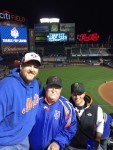
Terry Collins grew up watching baseball in an era when you had batting average, homeruns, and RBI to judge hitters. There was W-L record, ERA, and strikeouts to judge pitchers. Back then, utilizing the eye test was justifiable as there was no way to really quantify all you are seeing.
It’s important to keep this in mind when analyzing Terry Collins’ opinions on advanced statistics:
It’s become a young man’s game, especially with all of the technology stuff you’ve got to be involved in. I’m not very good at it. I don’t enjoy it like other people do. I’m not going to sit here and look at all of these [expletive] numbers and try to predict this guy is going to be a great player. OPS this. OPS that. GPS. LCSs. DSDs. You know who has good numbers? Good [expletive] players.
This quote reminds me of when I talk baseball with my Dad. He’s actually two years older than Terry Collins.
Whenever I talk to my Dad about baseball, I sometimes refer to advanced statistics. I will refer to WAR, FIP, UZR, etc. When I refer to them, he looks at me incredulously. He doesn’t know what they are. He doesn’t understand them. He asks me how to calculate them. I will give him a cursory explanation, but I can’t give him the exact formula. He can’t sit down and calculate it with his calculator. He’d rather talk about the statistics in which he’s more conversant.
The strange thing is I became interested in part due to my Dad. Growing up, he always told me to take W-L record with a grain of salt. He told me OBP was more important than batting average. He told me this in the 80’s! Back then merely suggesting that was heresy.
Now, we’re well beyond OBP and ERA being the advanced statistics to analyze. In many ways, Terry Collins is right. The game of baseball has passed them by. These newfangled statistics really are for a younger generation. Yet, we can all still enjoy baseball in our own way.
We don’t really need advanced statistics to tell us Matt Harvey is a really good pitcher. Yes, advanced statistics will support that conclusion. I love sitting there and watching games with my Dad. I remember in 2013 when he said that he expected Matt Harvey to throw a no-hitter every time he goes out to pitch. One night, we were there when it almost happened.
I love hearing my Dad tell me about how impossibly great Tom Seaver was. I love hearing him tell me that despite that he wanted Jerry Koosman on the mound for a big game.
So yes, how we analyze the game has changed since my Dad was a kid. Not to mention that teams are even trained differently from the days of old, with new technology and tools like the baseball swing trainer V2 and others available for anyone who aspires to be a solid player. It still doesn’t mean he doesn’t know a great player when he sees one. It doesn’t mean he doesn’t have a wealth of knowledge when it comes to the game of baseball. It doesn’t mean I don’t love talking baseball with him.
There will come a time when there are new statistics I won’t understand. I’ll be too old and set in my ways to learn the new ones. My son will roll his eyes at me when I refer to someone’s WAR or UZR. There’s going to be new statistics that will make all I think I know obsolete. That’s fine as long as we’re talking baseball (hopefully about his career). That’s all that matters.
No matter what happens, no matter what new statistics arise, the game never passes you by. As long as there are fathers and sons talking baseball, the game will belong to each and every generation. It will be a shared experience.
With that said, hopefully one day, my son will be able to explain to me what LCS and DSD is before I begin ignoring all thess newfangled statistics.
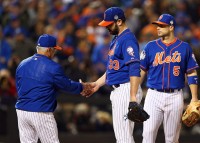
One of the many topics of this offseason has been about how all the Mets players love the team and how they want to stay here. Jacob deGrom said he would sign an extension. Now, it’s Matt Harvey‘s turn:
Matt Harvey said extension talk has never come up with the #Mets, but he hasn't "shied away" from it.
— Adam Rubin (@AdamRubinMedia) February 15, 2016
No, it’s not exactly a ringing endorsement. However, to me it’s a clear sign that he really is willing to sign an extension. Following Harvey’s career, there is no reason to believe otherwise.
Long before Harvey was drafted and became a part of the Mets organization, he was drafted by the Angels right out of high school. His association with Scott Boras raised questions about his signability. It caused him to slip to the third round. He informed the Angeld he would not sign unless he had a $2 million signing bonus. He would not accept $1.99 million. Accordingly, he would not accept the $1 million the Angels ultimately offered. Harvey rejected it despite his father telling him to take it, and he enrolled at the University of North Carolina.
Reading this, you may be led to believe that Harvey is just doing whatever Boras tells him to do. That premise should’ve been disproven after last year.
In 2012, Stephen Strasburg returned from Tommy John surgery, and he was famously shut down prior to the postseason. That decision was made when Scott Boras and GM Mike Rizzo agreed to Strasburg’s inning limits. Once Strasburg hit those limits, he was shut down. Boras tried to similarly intervene with Harvey.
As the timeline shows, Boras tried to get the Mets to limit Harvey to 180 innings. The main hurdle to that was it wasn’t what Harvey wanted to do. Instead of working with Sandy Alderson and Scott Boras, Harvey talked with his manager. It was Harvey and Terry Collins together that decided what Harvey needed to do. Harvey pitched more in September than the Mets, or Boras for that matter, thought he would pitch.
For better or worse, Harvey has always been in charge of his own career. It seems that on the field, he wants to compete at the highest level. For these actions, Harvey wants to be paid what he thinks he’s worth and not one penny less. That’s why Boras is his agent. He hired the guy who has a reputation of getting teams to pony up top dollar for the players he represents.
As noted by Adam Rubin today in his Morning Briefing, the belief that Boras’ clients don’t sign extensions prior to their hitting free agency is not entirely true. As Rubin notes, twenty-four of Boras’ clients have signed extensions with their teams before reaching free agency. Ironically, one of them was Jered Weaver, who signed an extension with the Angels; the same Angels who couldn’t find an extra million to sign Harvey.
So yes, it’s entirely possible the Mets can sign Harvey to an extension prior to his hitting free agency. Prior to this offseason, I would’ve been extremely pessimistic about the possibilities. However, this offseason the Mets re-signed Yoenis Cespedes thereby proving anything is possible.
I don’t know the Mets chances of re-signing Harvey. The only thing I do know is that Harvey is not going to accept one penny less than what he thinks he’s worth no matter what his family or his agent says.
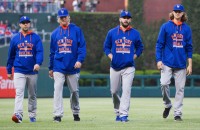
The general consensus as to why Hall of Famer Walter Johnson was so dominant was the saying, “You can’t hit what you can’t see.” In analyzing MLB’s Statcast data, that saying could now be applied to the young New York Mets pitching staff.
As the article notes, the Mets threw more pitches than any other team over 95 MPH. Nearly a thousand more. The main reason for this was the trio of Matt Harvey, Jacob deGrom, and Noah Syndergaard. Harvey’s two-seamer averaged 95.4, and his four seamer averaged 95.3. deGrom’s two seamer averaged 95.6, and his four seamer averaged 96.0. As all Mets fans know, Syndergaard led the pack. His two seamer averaged 98.3, and his four seamer averaged 98.4. Amongst starting pitchers Symdergaard threw the fastest.
This trio of hard throwing righties kept the Mets afloat in 2015 while the offense spluttered. When the team then assembled a major league capable offense, these pitchers led the Mets to the World Series. In 2016, it’s only going to get better.
Last year, the Mets had innings limits, skipped starts, and at times, six man rotations. Syndergaard wasn’t called up until May. In 2016, the Mets have said innings limits and the like will not be an issue. As such, all three of the Mets aces should be expected to make 32 starts and throw over 200 innings. This means more 95+ MPH fastballs. Again, batters will have trouble hitting the pitches they can’t see.
If that wasn’t enough, it gets even better. Steven Matz should start the year in the rotation. According to Brooks Baseball, Matz’s fastball averaged 94.57 MPH. Prior to Matz’s lat injury, his fastball averaged 94.90 MPH. With a full season of a healthy Matz, the Mets will further increase the amount of fastballs throw over 95 MPH.
In addition to a full season of Matz, the Mets can expect a half a season of Zack Wheeler. In Wheeler’s career, his four seamer averaged 95.87 MPH, and his sinker averaged 95.50 MPH. All told, upon Wheeler’s return, the Mets will feature a starting rotation that has five pitchers bringing the heat at over 95 MPH. That is just incredible.
However, why does it matter? Well, as FiveThirtyEight showed last year, it is just harder to hit a fastball that’s thrown 95 MPH and above. In total, batters swung and missed at pitches thrown this fast 22.8% of the time. That’s about 5-10% more frequent than pitches thrown slower.
More importantly, as we saw in last year’s NLCS, the Cubs are more likely to swing and miss at these pitches than any other team in baseball. Heading into the 2016 season, it appears that yet again it will be the Cubs standing in the Mets way. The pitching staff the Mets have constructed is not only effective against the Cubs, but also every single team in baseball.
The Mets 2016 pitching staff is the single best argument why any team in baseball will go to and win the World Series. The Mets young starters brought the heat last year. Next year will be more of the same.
Good luck to the National League next year because you can’t hit what you can’t see.
Editor’s Note: this article first appeared on metsmerizedonline.com
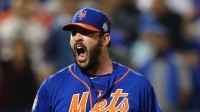
With Carlos Beltran giving his opinion on Terry Collins decision to send Matt Harvey back out for the ninth inning, I began to think of the different ways the Mets won or lost postseason series. Can you name the players involved in the last play in each of the Mets postseason series? Good luck!
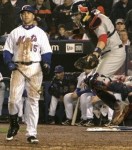
According to WAR, Carlos Beltran is the sixth best Met of all-time. He’s higher ranked than recent Hall of Fame inductee Mike Piazza. He’s a future Hall of Famer. The end of his Mets tenure was the beginning of Terry Collins tenure. When Beltran speaks, he deserves your full attention.
With that said, a person should always pick their spots when to interject an opinion. In his interview with George A. King, III, Beltran offered his opinions on Terry Collins sending Matt Harvey out for the ninth in Game 5 of the World Series. Collins’ decision ranks right up there with Grady Little leaving Pedro Martinez in during Game 7 of the 2003 ALCS. It’ll be talked about for generations. Everyone will have a perspective. For what it’s worth, here was Beltran’s take on Collins sending Harvey back out there:
He was looking down and I felt that he wanted to take Harvey out. But at the same time, Harvey was pitching such a good game and Harvey wanted that moment. He went with what Harvey showed him and not what he was thinking. That’s an experience for him. Later on [taking Harvey out] will happen. He will say,’My friend, I will give you a kiss of I have to, but I have to get my closer.’ It was a bad decision to leave him in, but in his heart I felt that he wanted to make a different move.
It’s a fine and reasonable take, but man, I really don’t want to hear Beltran talking about decision that lead to the end of playoff series. Much like the end of the 2015 World Series, his strikeout at the end of the 2006 NLCS will forever haunt Mets fans. For his part, Beltran said he couldn’t do anything with the pitch. To be fair, it was filthy:
However, with that said, he didn’t try to foul it off. He didn’t try to make a fielder make a play. There would be no little groundball up the first baseline. No, Beltran was beat, and he didn’t go down swinging. This doesn’t change the fact that he was a great Met. It doesn’t mean he shouldn’t be a Hall of Famer. It doesn’t even mean his opinion on Collins sending Harvey back out there was wrong.
No, it just means that when it comes to series altering decisions, Beltran’s opinion is the last one I want to hear.
Editor’s Note: this was first published on metsmerized.com
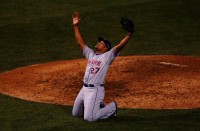
Last year, the Mets were carried by their pitching. It helped them sustain an anemic offense until the Mets got healthy and made trades. It helped carry them to the World Series. It’s the promise for the future.
That future first comes into question around 2019. That is the year that Matt Harvey becomes a free agent. Zack Wheeler could become a free agent the same year or the subsequent year. Two years later Jacob deGrom becomes a free agent. After that, the Mets will have to address the free agent case of Noah Syndergaard and Steven Matz. Naturally, this prompts the discussion of who the Mets should extend and when they should do it.
When these discussions take place, I find everyone to be extremely short-sided. Yes, it’s important to make a decision on the Mets starters, especially on Harvey, deGrom, and Syndergaard. However, I find that these discussions ignore Jeurys Familia. Like Harvey, Familia will be a free agent in 2019.
Familia was an exceedingly important part of the 2015 Mets. He was the stabilizing force at the back-end of a beleaguered bullpen. During 2015, Familia had the fifth most appearances. Of players who were strictly relievers, he had the third most innings pitched. He lead the league in games finished. He tied the Mets single season record for saves.
The advanced statistics also loved Familia’s 2015 season. He had an ERA+ of 200, which is astounding. It was the best amongst Mets pitchers. In fact, it’s a tick below Mariano Rivera‘s career 205 mark, which is the best in major league history. Familia’s FIP was 2.74, which, unsurprisingly, rates him as an excellent pitcher. Mariano’s career mark was 2.76. In essence, Familia’s 2015 was Riveraesque.
Keep in mind, Collins initially deployed Familia like Rivera. When it came time to close out the NLDS, Familia pitched two shutout innings. In the whole postseason, Familia had 12 appearances, and of those 12 appearances, he pitched more than one inning five times. He pitched 14.2 innings in those 12 appearances. Yes, he blew three saves in the World Series, but he only allowed one earned run the entire postseason. In reality, the blown saves were not on Familia but the Mets team as a whole.
Its important to lock-up some starting pitchers. If Harvey, deGrom, or Syndergaard leave, the Mets have other starters to keep having a strong rotation. If Familia were to leave, the Mets do not appear to have another reliever to take Familia’s spot. This makes extending Familia absolutely imperative.
So when it comes down to which Mets pitcher I would extend first, my answer is Jeurys Familia.
Editor’s Note: this article also appeared on metsmerizedonline.com
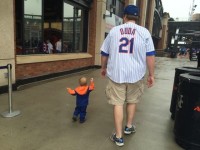
In my life, I’ve actually purchased very few Mets players jerseys. The first was Mike Piazza. After that it was David Wright and then Matt Harvey. I’ve received others as gifts (some requested), but those are at that I’ve purchased.
The one player jersey I always wanted was Daniel Murphy. I never purchased it. It seems that each and every year Murphy was a Met, he was rumored to be out the door. For various reasons a trade never materialized. I didn’t want to buy the jersey only for him to be traded the next day. Well, a funny thing happened. Murphy lasted seven years. He had a signature postseason game. He had the greatest postseason run for any Mets hitter ever. None of that should surprise us because Murphy was always incredibly clutch.
The time to purchase his jersey has passed because he’s gone. Sure, I could purchase one hoping I’ll see him again one day to get that autograph. I could wear it for the day he comes back to Citi Field. The thing is it wouldn’t make sense. Thinking about it, the Wright jersey, albeit outdated, is still good 11 years later. I could purchase another like a Yoenis Cespedes‘ jersey. However, he presents the same problems:
Cespedes is signed, but will he be around long enough to buy his jersey? KP has a flat in NYC for what? Hahn & Humpty next on @ESPNNY98_7FM
— Alan Hahn (@alanhahn) January 28, 2016
So right now, I have two Mets jerseys that’ll serve well for the 2016 season. The aforementioned Harvey jersey and the Lucas Duda jersey my son got me. If I’m going to purchase another, I’ll make sure it’s a player who will likely be around for more than one year.
Hopefully, that player will be with the Mets for at least seven years.
